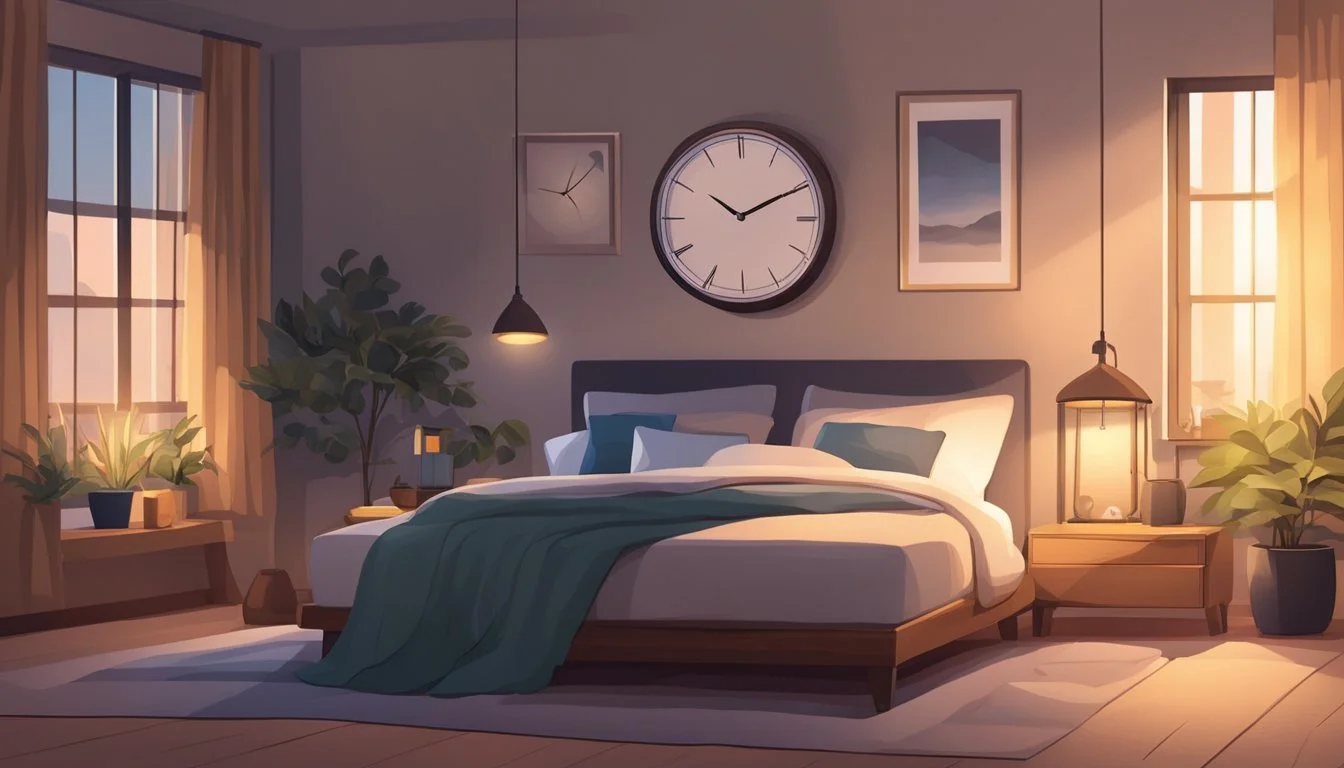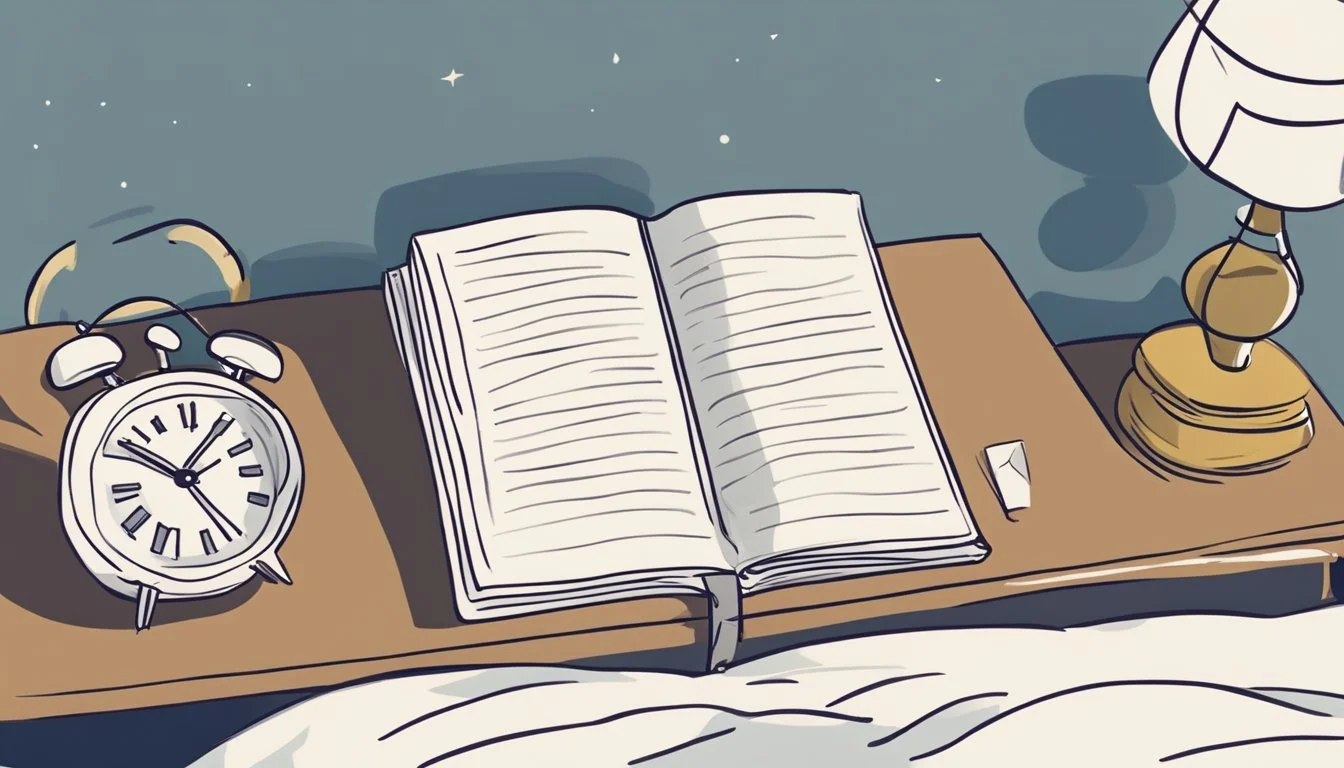13 Tricks to Falling Asleep in Under 5 Minutes
Expert-Backed Techniques for Rapid Slumber
Falling asleep quickly can be a challenge for many people. With busy schedules and constant distractions, it's common to find oneself tossing and turning at night, unable to drift off into a peaceful slumber. This can lead to frustration and sleep deprivation, affecting overall well-being and daily performance.
Fortunately, there are effective techniques that can help induce sleep rapidly. By implementing specific strategies and making simple adjustments to your bedtime routine, it's possible to fall asleep within just 5 minutes of laying down. These methods range from breathing exercises and relaxation techniques to environmental modifications and mental practices designed to calm the mind and prepare the body for rest.
1) Use a Weighted Blanket
Weighted blankets have gained popularity as a sleep aid. These heavy blankets typically weigh between 8 and 25 pounds and are designed to provide gentle pressure across the body.
The deep touch pressure from a weighted blanket can help lower heart rate and slow breathing. This promotes relaxation and may ease anxiety, making it easier to fall asleep quickly.
To use a weighted blanket effectively, cover the entire body from neck to toes. Some people prefer leaving their feet uncovered if they get too warm. Sleeping on your back allows for even pressure distribution, but side or stomach sleeping is fine too.
Start by using the blanket for short periods to acclimate. It can be layered over a top sheet for those who sleep cool. Choose a weight that's about 10% of your body weight for comfort and safety.
Weighted blankets may be especially helpful for those with insomnia or anxiety-related sleep issues. The calming effect is often compared to a hug or swaddling. Regular use can potentially lead to improved sleep quality and duration.
2) Try the 4-7-8 Breathing Technique
The 4-7-8 breathing technique is a simple yet effective method to help induce sleep quickly. Developed by Dr. Andrew Weil, this relaxation exercise can calm a racing mind and restless body in just a few minutes.
To practice this technique, begin by sitting or lying in a comfortable position. Inhale quietly through the nose for a count of four. Then, hold the breath for a count of seven.
Next, exhale completely through the mouth for a count of eight. This exhalation should make a whooshing sound. Repeat this cycle for a total of four breaths.
The 4-7-8 method works by increasing oxygen in the bloodstream, slowing the heart rate, and releasing carbon dioxide from the lungs. These physiological changes help promote a state of relaxation conducive to sleep.
Regular practice of this technique can enhance its effectiveness. Users may find it easier to fall asleep faster with consistent use. The 4-7-8 breathing method can also be helpful for reducing anxiety and stress throughout the day.
3) Listen to White Noise
White noise can be an effective tool for falling asleep quickly. This consistent, soothing sound helps mask disruptive noises that might otherwise keep you awake.
Many people find white noise calming and conducive to sleep. It creates a steady audio environment that can help quiet a busy mind and promote relaxation.
White noise machines, apps, or online videos offer various options. Some prefer pure white noise, while others enjoy nature sounds like rainfall or ocean waves.
Using white noise may help reduce the time it takes to fall asleep. It can be especially useful in noisy environments or for light sleepers easily disturbed by sounds.
Experiment with different types and volumes of white noise to find what works best. Some people prefer it louder, while others find a softer background hum more effective.
Consistency is key when using white noise for sleep. Making it part of a nightly routine can signal to your body that it's time to wind down and prepare for rest.
4) Dim Your Lights an Hour Before Bed
Dimming lights before bedtime plays a crucial role in preparing the body for sleep. As darkness falls, the brain naturally increases melatonin production, the hormone responsible for regulating sleep cycles.
By reducing artificial light exposure in the evening, one can support this natural process. Gradually lowering light levels signals to the body that it's time to wind down and prepare for rest.
Bright lights, especially blue light from electronic devices, can interfere with melatonin production. Dimming overhead lights and using softer, warmer light sources like lamps can create a more sleep-friendly environment.
Some people find it helpful to use dimmer switches or smart bulbs that can be programmed to automatically reduce brightness at a set time each evening. This removes the need to remember to adjust lighting manually.
Creating a consistent routine of dimming lights at the same time each night helps reinforce the body's natural sleep-wake cycle. This practice can lead to falling asleep more quickly and experiencing better quality sleep overall.
5) Read a Book (Paper Only)
Reading a paper book can be an effective way to induce sleep within minutes. The act of focusing on printed text helps calm the mind and reduce mental chatter.
Choose a book that is enjoyable but not overly exciting. Non-fiction or light fiction works well for this purpose. Avoid thrillers or action-packed stories that might keep you awake.
Find a comfortable position, preferably sitting up slightly to prevent dozing off too quickly. Use soft, warm lighting rather than harsh overhead lights or backlit screens.
Set a timer for 15-20 minutes to avoid reading for too long. This gives your body time to relax while preventing you from becoming too engrossed in the story.
If drowsiness sets in before the timer goes off, put the book aside and allow sleep to come naturally. The goal is to use reading as a transition to sleep, not to finish chapters.
6) Use Sleep-Inducing Scents like Lavender
Certain scents can promote relaxation and help individuals fall asleep faster. Lavender is one of the most well-known fragrances for improving sleep quality.
Research suggests that lavender can reduce anxiety and depression, common causes of insomnia. Its calming properties may help create a more conducive environment for rest.
There are several ways to incorporate lavender into a bedtime routine. Using an essential oil diffuser in the bedroom is a popular method. Adding a few drops of lavender oil to the diffuser about an hour before bed can help prepare the room for sleep.
Creating a homemade pillow spray with lavender essential oil is another option. This allows the scent to be close throughout the night, potentially enhancing its sleep-inducing effects.
For those who enjoy baths, adding lavender to an aromatherapy bath before bedtime can be both relaxing and sleep-promoting. The combination of warm water and soothing scent can prepare the body and mind for rest.
While lavender is a common choice, other scents like sandalwood may also help with sleep. Sandalwood's earthy aroma can promote relaxation and calmness, making it easier to drift off to sleep.
7) Practice Progressive Muscle Relaxation
Progressive muscle relaxation is an effective technique for falling asleep quickly. This method involves systematically tensing and relaxing different muscle groups throughout the body.
Start by tensing the muscles in your feet for 10 seconds, then release the tension and relax. Move up to your calves, thighs, and buttocks, repeating the process for each area.
Continue with your abdomen, chest, arms, hands, neck, and face. Focus on the sensation of tension followed by relaxation in each muscle group.
As you progress through your body, take slow, deep breaths. Inhale deeply through your nose for 4 seconds, hold for 7 seconds, and exhale slowly through your mouth for 8 seconds.
This technique helps reduce physical tension and mental stress, preparing your body for sleep. Regular practice can improve its effectiveness, making it easier to fall asleep within minutes.
Incorporate progressive muscle relaxation into your nightly routine for optimal results. Perform this exercise while lying in bed to seamlessly transition into sleep.
8) Keep Room Temperature Cool
A cool bedroom environment can significantly improve sleep quality and help you fall asleep faster. The ideal temperature for sleep typically ranges between 60°F and 70°F (15.5°C to 21°C).
Our bodies naturally experience a slight drop in core temperature as we prepare for sleep. A cooler room facilitates this process, making it easier to drift off quickly.
Consider using air conditioning or fans to maintain a comfortable temperature. In warmer months, closing curtains or blinds during the day can help keep the room cool.
Breathable bedding materials like cotton or bamboo can also promote better temperature regulation throughout the night. Avoid heavy blankets or comforters that may trap heat and cause discomfort.
If sharing a bed, consider using separate blankets to accommodate individual temperature preferences. This allows each person to adjust their coverage as needed for optimal comfort.
Experimenting with different temperatures can help identify the ideal setting for personal sleep needs. Small adjustments can make a significant difference in how quickly one falls asleep.
9) Avoid Caffeine After Noon
Caffeine can significantly impact sleep quality and make it harder to fall asleep quickly. To improve sleep onset, it's best to avoid consuming caffeine after midday.
Caffeine has a half-life of about 5-6 hours in the average adult. This means that several hours after consumption, caffeine is still active in the body and can interfere with sleep.
Even small amounts of caffeine consumed in the afternoon or evening can disrupt sleep patterns. Common sources include coffee, tea, chocolate, and some sodas.
For optimal sleep, experts recommend cutting off caffeine intake at least 8 hours before bedtime. This allows enough time for the body to metabolize most of the caffeine.
Those sensitive to caffeine may need to stop consumption even earlier in the day. Individuals should pay attention to how caffeine affects them personally and adjust accordingly.
Switching to decaf or herbal tea options in the afternoon can help satisfy cravings without disrupting sleep. Water is always a great caffeine-free choice to stay hydrated.
10) Drink Herbal Tea (like Chamomile)
Drinking herbal tea before bedtime can promote relaxation and improve sleep quality. Chamomile tea is particularly effective due to its mild sedative properties.
Chamomile contains apigenin, an antioxidant that binds to certain receptors in the brain, potentially inducing sleepiness. Other beneficial herbal teas include lavender, valerian root, and passionflower.
To prepare, steep a tea bag or loose herbs in hot water for 5-10 minutes. Allow the tea to cool slightly before drinking. It's best consumed 30-60 minutes before bedtime to allow time for the effects to set in.
Some people find that adding a small amount of honey enhances the tea's flavor and soothing properties. Avoid adding caffeine-containing ingredients, as these may counteract the sleep-promoting effects.
Regular consumption of herbal tea can become a calming pre-sleep ritual, signaling to the body that it's time to wind down. This practice, combined with other relaxation techniques, may help reduce the time it takes to fall asleep.
11) Engage in Gentle Yoga Before Bed
Gentle yoga before bed can promote relaxation and improve sleep quality. A few simple poses can help release tension and calm the mind, preparing the body for rest.
Child's pose is an excellent starting position. Kneeling with toes touching and knees apart, sit back on the heels and extend arms forward, lowering the torso and bringing the forehead to the mat.
Cat-cow pose can help release spinal tension. On hands and knees, alternate between arching the back and rounding it while breathing deeply.
Side stretches can be performed while seated. Reach one arm up and over, leaning to the opposite side. Hold for a few breaths, then switch sides.
Legs up the wall is a restorative pose. Lie on the back with legs extended up a wall, allowing gravity to aid circulation and promote relaxation.
Practice these poses for 5-10 minutes before bed. Focus on slow, deep breathing throughout the routine to maximize the calming effects and prepare for sleep.
12) Write Down Your Thoughts in a Journal
Journaling before bed can significantly aid in falling asleep quickly. This practice allows individuals to process their thoughts and emotions from the day.
Writing down worries and concerns can help clear the mind, reducing anxiety that might otherwise keep one awake. It also provides an opportunity to reflect on positive experiences and express gratitude.
Creating a bedtime journaling routine can be simple. One can start by finding a quiet, comfortable space and setting aside a specific time each night for writing.
There's no need to focus on perfect grammar or spelling. The goal is to get thoughts onto paper, helping to declutter the mind before sleep.
For those who struggle to begin, using prompts can be helpful. These might include reflecting on the day's events, listing things to be grateful for, or writing down goals for the next day.
Journaling can also serve as a form of self-care and personal growth. It allows individuals to track their progress, identify patterns in their thoughts and behaviors, and set intentions for improvement.
13) Keep a Consistent Sleep Schedule
Maintaining a regular sleep schedule is crucial for falling asleep quickly. The body's internal clock, or circadian rhythm, thrives on consistency.
Going to bed and waking up at the same time every day, even on weekends, helps regulate this natural rhythm. This practice reinforces the body's sleep-wake cycle.
Over time, a consistent schedule can train the body to feel sleepy at the right time each night. It also promotes more restful sleep and easier wake-ups in the morning.
Aim for 7-9 hours of sleep per night, adjusting based on individual needs. Stick to the chosen bedtime, even if not feeling tired initially.
Avoid naps late in the day, as they can disrupt nighttime sleep patterns. If necessary, limit naps to 20-30 minutes in the early afternoon.
Consistency extends to other daily activities as well. Regular meal times and exercise routines can further support a stable sleep schedule.
Understanding Sleep Cycles
Sleep cycles are complex biological processes that occur during the night. They consist of distinct stages that repeat throughout sleep, each playing a crucial role in rest and restoration.
Stages of Sleep
Sleep progresses through four main stages. Stage 1 is light sleep, where you drift in and out of consciousness. Stage 2 involves a drop in body temperature and slowed heart rate. Stages 3 and 4 are deep sleep, characterized by slow brain waves.
During deep sleep, the body repairs tissues, builds bone and muscle, and strengthens the immune system. This restorative phase is essential for physical recovery.
Why Rapid Eye Movement (REM) Is Crucial
REM sleep typically occurs 90 minutes after falling asleep. During this stage, brain activity increases and vivid dreams occur. Eyes move rapidly beneath closed lids.
REM sleep is vital for cognitive functions such as memory consolidation and learning. It helps process emotions and experiences from the day. Adequate REM sleep improves problem-solving skills and creativity.
A full night's sleep includes multiple REM cycles. Each cycle typically lasts longer as the night progresses. Getting enough REM sleep is crucial for mental well-being and cognitive performance.
The Science Behind Falling Asleep Quickly
Falling asleep quickly involves complex biological processes influenced by our circadian rhythms and relaxation responses. These mechanisms work together to transition our bodies and minds from wakefulness to sleep.
Role of the Circadian Rhythm
The circadian rhythm acts as our internal biological clock, regulating sleep-wake cycles over a 24-hour period. This system is controlled by the suprachiasmatic nucleus in the brain, which responds to light and dark cues from the environment.
As evening approaches, the circadian rhythm triggers the release of melatonin, a hormone that promotes sleepiness. This natural process begins about 2 hours before bedtime, gradually increasing drowsiness.
Exposure to blue light from electronic devices can disrupt this rhythm by suppressing melatonin production. Maintaining a consistent sleep schedule helps synchronize the circadian rhythm, making it easier to fall asleep quickly at night.
Impact of Relaxation Techniques
Relaxation techniques can significantly speed up the process of falling asleep by activating the parasympathetic nervous system. This system counteracts the effects of stress and promotes a state of calm.
Deep breathing exercises, such as the 4-7-8 technique, can lower heart rate and blood pressure. This physiological shift signals to the body that it's safe to relax and fall asleep.
Progressive muscle relaxation involves tensing and releasing different muscle groups. This practice reduces physical tension and mental anxiety, preparing the body for sleep.
Visualization and mindfulness meditation can quiet racing thoughts by focusing attention away from stressors. These techniques help create a mental state conducive to falling asleep quickly.






